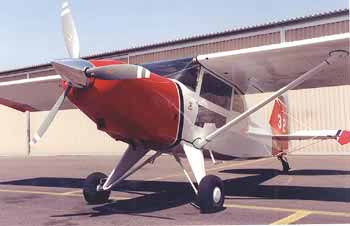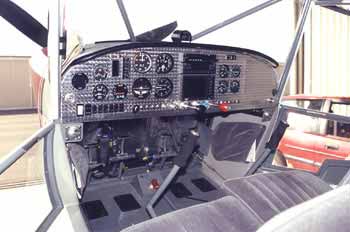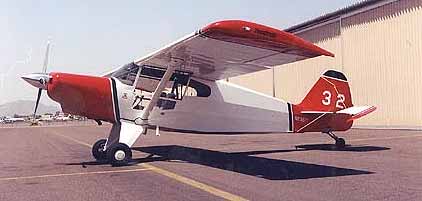
Pirep:
Bearhawk 232PF, Pat Fagan’s Bird

Pirep:
Bearhawk 232PF, Pat Fagan’s Bird
To keep this thing from rambling on I’m going to try to abbreviate it and mention high points only, although by the time you’re done reading this, you’ll find it hard to believe it’s abbreviated.
Pat took an incredible amount of time and energy to come over, do a bunch of flying, sweat his butt off and, in general, play the ambassador role for the Clan Bearhawk. Not many folks would do that and, I, for one, thank him mightily for it.
We flew about 2.5 hours together and on top of that, he hopped another five or six passengers, including the AZ Redhead who won’t stop talking about it.
 |
 |
 |
 |
The rudder on Pat's airplane felt noticeably different than on Bob's two prototypes. As I understand it, Bob redrew the aerodynamic balance on all the plans and reduced the size of the balance. Originally the rudder was extremely light with little break-out force, but Pat's is perfectly matched to the ailerons and rudders. In fact, the controls are as well balanced as you'll find on any airplane of any type.
Stalls
I did a lot of messing around at stall and sub-stall speeds. Clean it bobbles a little and mushes at about 42 knots. With full flaps (Pat isn’t getting a full 50 degrees) it comes down closer to 35 knots. Using power to hold altitude, I ran it down under 30 knots and made turns left and right and it showed no tendency to do anything stupid.
I did some deep stalls (full stall and left the stick nailed full back) and played with the ailerons and rudder. Both are still working and with the stick full back I could execute gentle turns left and right. If I got aggressive with the ailerons you could feel them nibbling and getting ready to stall.
Since we were going to try some slow approaches, I set it up at 40 knots with power and drove it around trying steeper and steeper banks and didn’t feel it wanted to do anything but fly. I did the same thing at 35 knots with the same result.
As the airplane goes under 45-50 knots the controls all get softer, as you’d expect, but that’s largely an illusion as they are still working but need bigger deflections to make things happen the way you want them to.
One thing that did make slow flight difficult and was to haunt us a little when playing with slow approaches was that we ran out of trim at around 60 knots. This meant we were holding increasingly heavier stick forces the slower we went. The forces never became burdensome, but they were making it difficult to stabilize at super slow speeds.
Pat has his trim linkage at the very end of the trim arm on the elevator but has another hole further in. He’s going to move the arm in, which will increase the trim tab travel and see if that gives him a slower minimum trim speed. It will make his trim more sensitive but it isn’t very sensitive to begin with so it probably won’t be a problem. We’ll let him tell us whether it helps or is more trouble than it’s worth.
 |
Skylight Comments
Because you sit so far back in the wing, in a normal Bearhawk, visibility is of the pick-up-the-wing-before-you-turn variety. In Pat’s you had to do the same thing, but as soon as a bank over 15-20 degrees was established, you could see over the down wing. It was great and something well worth doing.
Pat flattened out the top of the fuselage, getting rid of the Bearhawk Hump, which very much squares off the fuselage lines. This is noticeable all the way back to the tail but not particularly objectionable. We (AviPro) raised the stringer line just in front of the fin an inch to make the fuselage more rounded in that area and we’re going to look at a way to put skylights in the fuselage without flattening it out.
To answer those who are saying, "Sky lights are entirely too hot," I have to reply that I'd agree with you, but not in this case. The tint of the skylight is such that you aren't even aware it's tinted from the inside, but not once did I even notice the sun and believe me, we had plenty. It was a perfect balance of visibility and comfort.
Landings/approaches
My first landings were all made at 50 knots at which speed the airplane is totally normal in all respects. Also, since it bleeds off to well under 40 during the flair, runway control isn’t even worth talking about because you’re moving so slowly. I still don’t know why people ask us about a nose wheel for the airplane. There are very few taildraggers that are easier to fly.
I started out with three notches of flaps but quickly decided I liked it better at full flaps because it got the nose down further and the speed bleed during flair was a little quicker. In many airplanes this would make the flair timing-critical (you have to rotate just right to keep from dropping it) but that wasn’t the case here. Even at full flap (something short of 50 degrees, Pat is going to measure and let us know what he has), power-off rotation from a stabilized glide was no sweat.
When I got it down to 45 knots, the first time or two I found myself using a little power in the flair to help get the tail down because I didn’t think it would rotate, but later I found the power wasn’t needed. It had sufficient elevator power left to get the tail down and this was at a far forward CG location. With people in the back or a load, it will probably flair into three-point at 45 just like it does at 50.
When we got down to 40 knots on short approach things got a little more difficult because of the amount of backpressure we were holding. This wouldn’t be a factor because the backpressure isn’t that high but it is aggravated by the way the elevator effectiveness changes with power.
When you get down to 40 knots, the elevator effectiveness naturally diminishes but it’s not anything you notice. However, both Pat and I did the same thing once a piece. We were shooting for the numbers and got just a little low and were late putting the power in. The second we hit the power (just a hint of it but too big of a hint), the tail surfaces instantly became totally effective and the amount of backpressure we were holding became too much and the nose shot into the air.
This is a pilot technique problem not an airplane handling problem. If you hold the nose stable (this is in Student Pilot 101, I believe), when applying power in this situation, you don’t get balloons. Next time around we didn’t do that.
The balloons taught us something, however. When Pat did his, I kept my eyes in the cockpit (I hate watching crashes in which I'm actively involved) and studied the airspeed as he recovered. We were a little under 40 knots when the nose jumped and we started up hill. We were decelerating through 35 knots on the top and he kept pulling as we came down while he added power. We went down through 32 knots and arrived on the runway tailwheel first in what he thought was a hard landing but which I thought was only a little harder than usual. By the way, the airplane barely bounced, a sterling testimony to the Bob shock system.
What was of some importance during this little whoop-dee-do was that the tailwind was screwing with us, trying to shove the airplane around and at no time, even though we were hanging there at 32-35 knots, was control an issue.
Personally, I’d bet money that if we had another hour to practice, in more normal wind and temperature conditions, we’d become perfectly comfortable making 35-knot approaches.
Because of the goofy wind conditions I was never able to determine a speed at which it slid over the backside of the drag curve and began falling for the ground, thereby transferring most glide slope control to the throttle. In fact, it felt as if there was no such point and it kept flying all the way down. This will take more investigation.
In summarizing the landings, I’d say that 50-55 knots should be considered the normal approach speed and three notches used. We didn’t do any landings with two notches but I’d ignore it for landing and use that position only for takeoff.
Incidentally, even though it was 100-103 degrees (runway temps probably MUCH higher) and we had a tailwind, we still turned off on the first taxiway after the threshold much of the time and that’s 400 feet. With no wind, even at those temps it would have been a no-brainer. With 5 knots on the nose we could have backed into that space :-)
I’m really looking forward to flying the airplane in more user-friendly conditions. We’ve established that it has no serious boogie-men hiding at the bottom end of the airspeed indicator so now it’s time to figure out how best to use those capabilities.